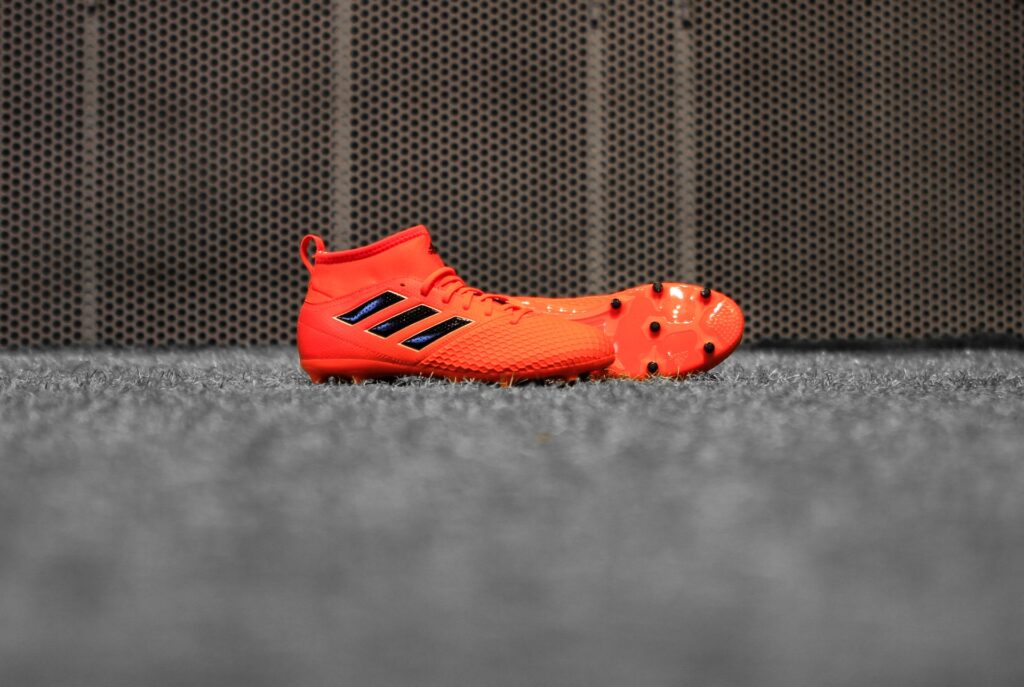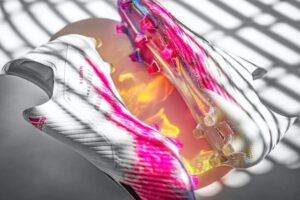Table of Contents
- What’s the difference between soccer and football cleats?
- The difference between soccer and football cleats (Comparison)
- Can soccer cleats be used for football?
- Can football cleats be used for baseball?
- Recap: The difference between soccer and football cleats
Wondering about the difference between soccer and football cleats? You’ve come to the right place!
If you’re watching a game on TV, you might not notice the differences between soccer cleats and football cleats. From afar, they look quite similar.
However, there are subtle aspects of each cleat that are designed to help the athletes perform to a high standard.
To find out these differences, we’ve assessed the key differences and similarities so you know what to look out for.
What’s the difference between soccer and football cleats?
Each sport has cleats designed to suit the needs of the participants. Years of research from manufacturers mean a high degree of suitability is achieved for each set of cleats.
Because football has greater physicality and requires quick and sudden bursts, there is a stud near the big toe to help propel the runner.
Football cleats can go high up the ankle, whereas soccer cleats don’t generally do the same, instead finishing below the heel.
The difference between soccer and football cleats (Comparison)
There are some differences that are obvious, but others are discrete. Soccer cleats and football cleats aren’t the same and are designed specifically for each game:
Design
Soccer requires comfort so that the players can run for long periods of time and move freely.
The large stud near the toe isn’t as common in soccer because, although there is sprinting, there is less chance of sprinting from a static position. The toe stud wouldn’t be as beneficial as it is in football.
Whereas, in football, players frequently accelerate from a position where they are standing still. This toe stud helps propel them in the same way a sprinter sets off in a 100-meter race.
Weight
This is because soccer requires a great deal of stamina when compared to football.
The lightweight feel of soccer cleats is necessary so that there is no restriction.
Football cleats aren’t exactly heavy or restrictive, but compared to soccer cleats, they are sometimes thicker depending on the position you play. Certain positions that require speed might choose to have lightweight cleats, too.
Soccer players are running for a lot longer periods, so their cleats need to be lighter and offer more flexibility.
Height

It can vary on the position you play in football, but a lot of players decide to have cleats that go higher up their ankle in football than others.
This is because of the more physical nature of the sport, offering as much protection as possible in a game that is very impactful on the lower body. Therefore, linemen in football might choose the higher-cut boots compared to players tasked with outpacing their opponent.
Soccer players almost universally prefer lower-cut cleats. High-cut ankle cleats were somewhat popular around 20 years ago, but nearly every player chooses to have less restriction around their ankles when it comes to choosing footwear.
Sole
As we know, soccer is all about controlling the ball with your feet, and making sure the footwear you have is crucial to doing this successfully.
This is a key reason why midsoles, which run through the middle section of your cleats, aren’t often found on soccer cleats.
If you imagine trying to control a soccer ball with your running shoes, which typically feature midsoles, you’ll know why soccer players don’t want this.
It feels much more natural to soccer players without the midsole so that they can play more comfortably.
This isn’t as much of an issue in football, where the players might decide on having the midsoles because it offers support and the need for ball control with feet isn’t necessary.
Midsoles are lacking in soccer cleats because it suits the way players need to control the ball with their feet. This isn’t an issue in football, where players who aren’t kickers or punters only use their hands to control the ball.
Brands
Two of the big names in sports generally make both football cleats and soccer cleats: Nike and Adidas.
The companies have been involved with either sport for a number of years and have thoroughly researched the optimal styles and designs to suit their players.
There are many other brands, of course, who supply cleats for both sports. Under Armour is another high-profile name.
Due to the more international nature of soccer, there appear to be many more brands that make soccer cleats than seem to be involved with supplying football cleats.
Some of these names include Macron, Umbro, Hummel, Joma, and countless others.
Price
Buying sports footwear can be expensive, depending on the brand and design you choose.
One study found that the average price of a pair of soccer cleats in 2021 was almost $150 and the prices have risen year on year.
The same company found that football cleats cost just over $110.
As is the way in both sports, this varies by brand. Nike and Adidas offer some more affordable options but are often deemed as more desirable, so can cost more than less-known brands.
Can soccer cleats be used for football?

While soccer cleats could be used for football, it’s advisable to check you’ve got the appropriate protection for your position.
Football-specific cleats will offer more protection and help you accelerate from a motionless position easier.
Although, many kickers decide to wear soccer cleats because of their lightweight feel and the fact that they’re designed to kick a ball.
Football’s rules allow for soccer cleats to be worn, but not the other way around.
Can football cleats be used for baseball?
Similarly, it might be possible to play baseball in football cleats, but it’s for the best that you purchase cleats that are designed to be used for each specific sport.
A lot of players decide to wear football cleats on a baseball field, though, because there are many similarities.
Recap: The difference between soccer and football cleats
There are some similarities but the differences are important to what helps each athlete perform to the highest standard possible.
Of course, there is a safety issue when it comes to choosing the right footwear too, so you need to make sure they feel good and secure.
Looking for the best soccer cleats for the upcoming season? Check out this article, where we introduce you to a complete guide to buying soccer cleats. You might also find this piece on metal stud soccer cleats helpful, particularly if you’re playing soccer in the winter.

